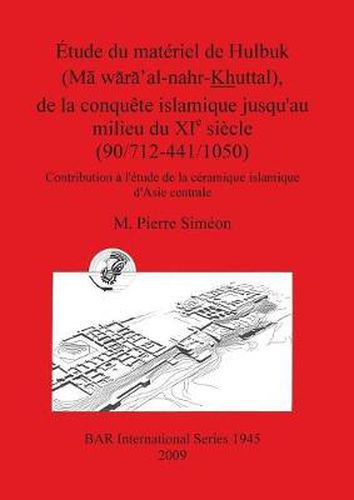Etude du materiel de Hulbuk (M waxa' al-nahr Khuttal) de la conquete islamique jusqu'au milieu du XIe siecle (90/712-441/1050): Contribution a l'etude de la ceramique islamique d'Asie centrale
M Pierre Simeon

Etude du materiel de Hulbuk (M waxa’ al-nahr Khuttal) de la conquete islamique jusqu'au milieu du XIe siecle (90/712-441/1050): Contribution a l'etude de la ceramique islamique d'Asie centrale
M Pierre Simeon
This title is printed to order. This book may have been self-published. If so, we cannot guarantee the quality of the content. In the main most books will have gone through the editing process however some may not. We therefore suggest that you be aware of this before ordering this book. If in doubt check either the author or publisher’s details as we are unable to accept any returns unless they are faulty. Please contact us if you have any questions.
This study sets forth a typological classification of hitherto undocumented ceramic artefacts from the Hulbuk excavation site (south east of Tadjikistan, Kuliob district). This material from the ninth to the mid-eleventh century, collected from 1953 to 1978 by the Russian-Tadjik campaigns, mainly comes from the citadel, some wells located in the lower part of the city and from one or two kilns. Concentrating on this site - the capital of Khuttal - the author focuses on the material culture of the Turkish-Iranian dynasty. Previous research in this area has not been on the same scale as that undertaken in mediaeval Central Asia (West to East Turkmenistan, Uzbekistan, Tajikistan, Kirghizstan and South Kazakhstan). The chronological period in question is rich in technical innovations and decorative creations. The ninth century saw the beginning of the development of glazed pottery. Under the Abbasids, considerable advances were made in science, in particular chemistry, and this led to the emergence of techniques, such as glaze, which modified the ceramic craft. In Part 1, the author examines specific aspects of the geography and history of Central Asia at the beginning of medieval period (the eighth to the eleventh century) to shed light on the extent to which this vast central-Asian area was physically and ideologically conquered. Regarding the Arab-Islamic conquest of this area, the study shows as far as is possible how a new culture and religion penetrated these countries, presenting also the influence of Near-East dynasties and the gradual lack of control of the caliph on local dynasties. Contacts and political tensions with China and tribal Turks are also taken into consideration. For the ceramic study (Part 2), the author puts in place a typology according to: fabric and shape for glazed and unglazed pottery; the nature of the glaze and decoration; and additives in the glaze-ware. This research offers an important ceramics corpus in a new typo-morphology, of interest to historians and archaeologists working on central-Asian Islamic pottery. Part 3 deals with the technical particularities of this geographical area, presenting a typology of ceramics produced in Hulbuk, and highlighted specific elements required for the manufacture of pottery (moulds), including placing and firing the pottery in the kiln. Part 4 deals briefly with the distribution of glazed and unglazed types of mains ceramics and commercial paths according to the historical sources.
This item is not currently in-stock. It can be ordered online and is expected to ship in 7-14 days
Our stock data is updated periodically, and availability may change throughout the day for in-demand items. Please call the relevant shop for the most current stock information. Prices are subject to change without notice.
Sign in or become a Readings Member to add this title to a wishlist.

